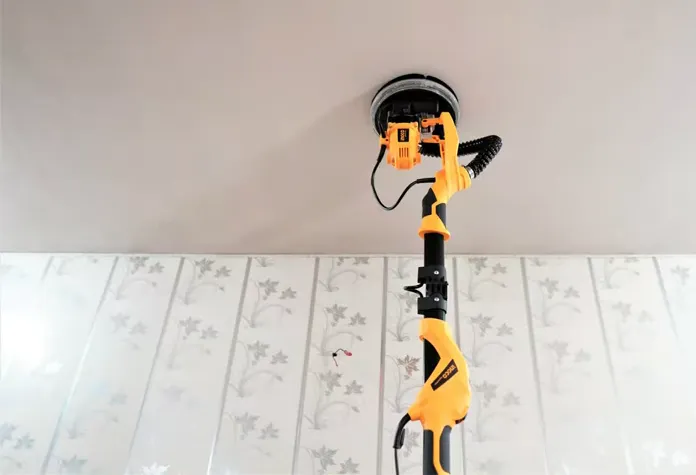How to Safely Operate a Disc Sander in 2024?
Are you aware that improper use of a disc sander can lead to serious injuries?
With the increasing use of advanced tools in woodworking projects, safety remains important. In 2024, the safe operation of disc sanders is essential due to their latest features and powerful capabilities. This guide will help you safely operate a disc sander, protecting yourself and ensuring the best results in your projects.
So, let’s continue reading the article to become a pro at operating disc sander.

2024 Disc Sander: What’s New?
A disc sander is a versatile tool used to smooth surfaces by abrasion. It mainly consists of a circular sandpaper disc attached to a rotating wheel. Disc sanders in 2024 have evolved with modern technology to enhance both safety and efficiency for users. These revolutions cater to expert needs for smoother operations and more significant accuracy in every project.
With a focus on user safety and machine longevity, the latest disc sanders incorporate advanced features that set them apart. Below are some key features you can expect in 2024 disc sanders:
- Auto-stop technology: Automatically shuts off the sander to prevent overheating or malfunction.
- Enhanced dust collection systems: Reduces airborne particles for a cleaner workspace.
- Smart technology integration: Monitors performance and alerts users to potential issues.
- Variable speed control: Offers greater flexibility for different materials and tasks.
Key Components to Know
Understanding the key components of a disc sander is necessary for safe and efficient operation. Each part plays an integral role in providing smooth performance and achieving the desired results in your projects.
Familiarizing yourself with these components will help you maintain your disc sander properly and use it to its full potential.
- Abrasive Disc: The circular sanding surface that grinds and smooths materials.
- Motor: Powers the disc to provide the necessary rotation and speed.
- Table: The flat surface where the material is placed and supported during sanding.
- Dust Collection Port: Connects to a vacuum system to capture dust and debris.
- Safety Guard: Shields the user from flying particles and accidental contact with the disc.
Pre-Operation Safety Checklist
To ensure safe and efficient use of your disc sander, follow these pre-operation steps:
- Conduct a Thorough Inspection: Before turning on the disc sander, check for any signs of wear and tear, loose parts, or other damage that could affect its performance.
- Set Up a Safe Workspace: Ensure the area is clean, well-lit, and free from clutter to avoid any tripping or slipping hazards.
- Wear Appropriate Safety Gear: Equip yourself with goggles, gloves, a dust mask, and hearing protection to protect yourself from potential hazards.
- Secure the Sander: Make sure the sander is securely mounted or placed on a stable surface to prevent it from shifting during operation.
Safe Operating Procedures
After completing the pre-operation checks, follow these steps to safely start using the disc sander:
- Ensure a Stable Stance: Position your feet shoulder-width apart to maintain control over the tool.
- Position Your Hands: Keep your hands clear of the spinning disc to avoid injury.
- Apply Steady Pressure: Feed material into the sander with consistent pressure without forcing it, allowing the tool to operate effectively.
- Prevent Kickback: Applying steady pressure helps prevent kickback, a common cause of accidents.
- Adjust Techniques for Different Materials: Tailor your sanding approach based on the material. For instance, adjust the pressure and speed for wood versus metal.
Following these steps ensures the safe and efficient operation of the disc sander.
Risks of Bypassing Safe Operating Procedures
- Ignoring safety features increases the risk of accidents, like kickbacks or tool malfunctions.
- Modifying the tool can lead to serious injuries or damage.
- Skipping safety checks may result in equipment damage or reduced tool lifespan.
- Rushing the sanding process can compromise safety and work quality.
- Sticking to safety guidelines ensures both personal safety and the best performance.
Common Mistakes to Avoid
To ensure safety while operating a disc sander, avoid these common pitfalls:
- Rushing Through the Sanding Process: Speeding up the process can lead to errors that compromise safety. Take your time to work carefully and avoid unnecessary risks.
- Overloading the Sander: Applying excessive pressure can strain the motor and heighten the risk of malfunction. Use the sander within its recommended limits.
- Ignoring Unusual Noises or Vibrations: If you hear strange sounds or feel vibrations, stop the machine immediately and inspect it for issues. Ignoring these signs can lead to more severe problems.
- Bypassing Safety Features: Never disable or modify safety features. Such actions can void warranties and increase the risk of accidents.

Advanced Safety Tips for 2024
To ensure safety while operating disc sanders, consider the following key points:
- Advanced Safety Features: Modern disc sanders are equipped with enhanced safety features, such as smart technology options.
- Auto-Stop Functions: Use auto-stop functions to automatically halt the sander in case of emergencies.
- Integrated Dust Collection Systems: Use integrated dust collection systems to reduce exposure to harmful dust and debris.
- Regular Maintenance: Regularly clean the sander and inspect it for any necessary updates or recalls from the manufacturer.
- Stay Informed: Be updated with the latest safety developments to ensure your operation follows the highest standards.
These measures will help you operate disc sanders with increased safety and efficiency.
Emergency Protocols
Despite all precautions, accidents can still happen. Knowing what to do in an emergency is crucial. If an accident occurs, quickly shut down the disc sander and provide first aid if necessary. In severe cases, seek medical attention immediately.
Learning how to safely shut down the machine during a malfunction can prevent further injury. Report any defects or issues with the sander to the manufacturer or retailer to prevent similar problems for others.
Conclusion
Operating a disc sander safely needs good knowledge, preparation, and attentiveness. By following these guidelines, users can greatly reduce accident risks and ensure a successful, injury-free project. Always prioritise safety, stay updated with the latest advancements, and never underestimate the importance of proper technique.
By following these practices, your disc sander will enhance workshop safety and deliver professional results efficiently. Moreover, discover detailed reviews and comparisons of the latest disc sander models on our site.
Find out more about which sander is best for deck refinishing: Drum Sander or Orbital Sander.


